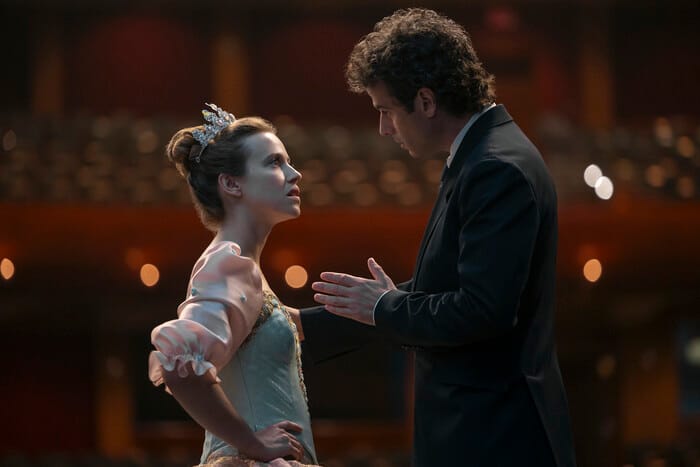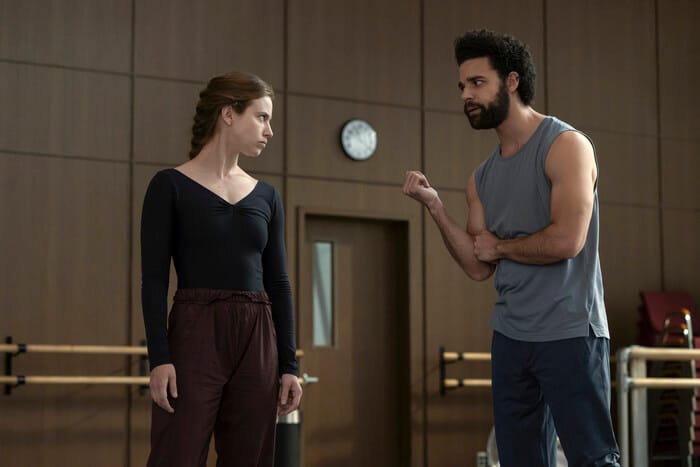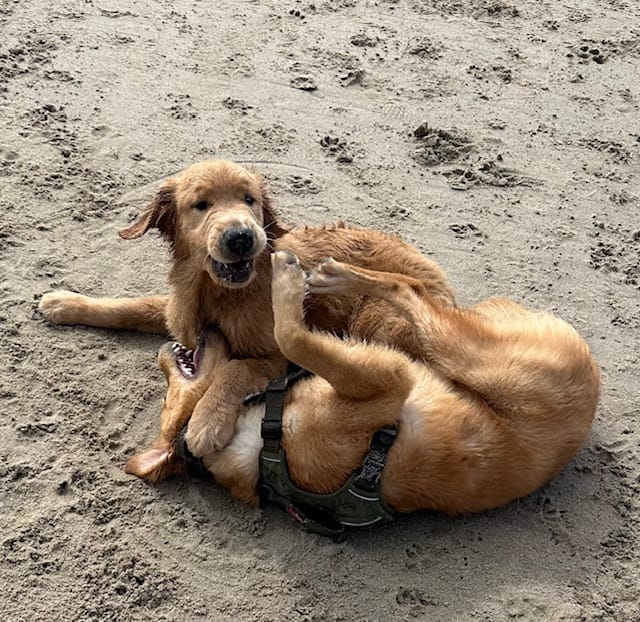"Etoile": Dancing Through High Culture's Extinction

"The arts are under siege," says Amy Sherman Palladino, and that sets the stage for an engaging romp that shows the battle up close
When Lou de Laage first appears before us as Cheyenne in “Etoile,” she’s a whirling waterspout of eco-warrior wrath, railing against the crew of the fishing vessel she and her shipmates are besieging on stormy seas. Smudged and battered--in an abrupt bit of slapstick she accidentally hip-checks a shipmate into the heaving seas– she completely intimidates her own boat’s crew.
Cheyenne—it’s pronounced “shay-ENNE” with emphasis on the second syllable—is unfazed when cops arrest her back onshore, and a signal moment arrives as one of the officers cuffing her is revealed as a benevolently smiling, blue-uniformed superfan of this hellcat. She happens to a be the top star—an etoile among etoiles—of the French national ballet troupe, and le flic wants a selfie he and his wife can cherish. We at once begin to like her as she accedes to this request from an evident man of the people, who happens to be a man of color, and thenceforth watch her we must, as her features toggle from often incensed to a much rarer but winning spaniel’s pout.
Before we’ve even seen her move onstage, transforming from a living question mark into a fluid ampersand, we’ve learned that Cheyenne’s a French national treasure. Just try to avoid getting hooked on watching the actress, who when cast spoke scant English and had minimal dance training. A veteran of 15 years in the game , she’s been most celebrated as the student doctor Mathilde in Anne Fontaine’s 2016 “Innocents,” in which her student doctor character brings succor to a convent of nuns victimized by Red Army troops in post-WWII Poland.
Cheyenne will ricochet between the series’ two lightly fictional dance companies, dubbed the Ballet National in Paris and The New York Metropolitan Ballet. She’s the lynchpin of a swap whereby each operation seeks to revive lagging ticket sales and survive post-pandemic economic straits. Complaining of the abrupt transatlantic flights (big jets burn four litres of fuel a second, she snaps), she can, fortunately for the backstage drama of it all, act as the pivotal figure in both dance camps.
It's not a stretch; ballet has since the days of Nijinsky in the Ballets Russes and later Margot Fonteyn with the Royal Ballet, relied on its superstars to put aesthete fannies in seats. (Nureyev first joined Dame Margot in “Giselle” in London in 1961.)
That was then, and philistinism is now. On May 2nd, Trump’s newly announced budget proposals marked for elimination both the National Endowment for the Arts and the National Endowment for the Humanities—a defrocking of arts funding he tried and that failed to execute in his first term.
Arts funding was already undergoing a several-year trough, as Helen Shaw depcits this week in the New Yorker, and she quotes a prescient framing by Playwrights Horizons artistic director Adam Greenfield: “If the arts are, as I believe, a tool of democracy and a powerful safeguard against oppression, then in this moment—considering the intersecting strains we’re facing (inflation, corporatization, federal cuts)—the stakes of arts funding couldn’t be higher.”
With Trump as his own culture minister and surrounded by know-nothings, there’s not much cause for optimism. We now wait to see what violence he may wreak, most especially on the American Ballet Theatre, which is heavily funded by the federal government. (The French state has long underwritten their own Paris Opera Ballet—largely the model for what’s called the French National Ballet in “Etoile”—with aplomb and none of the anti-woke bias Trump seeks to enforce.) As it happens, one of the last attractions to play the Kennedy Center in February, before the Mad King fully took over as chair and chief booker, was a chiefly female cast in an adaptation of “Crime and Punishment.” (The President seems to have the crime part handled, especially with a Supreme Court that’s gone totally slack on the notion of punishment.)
Having introduced Cheyenne as what one colleague will call “the worst people person,” the story and its accompanying ensemble of actors orbit around her as we watch a showbiz fable in which a sacred monster of performance strains to find her own heart on and offstage.
As auxiliary characters emerge, we will discover that, while Cheyenne’s fierce and often surly independence jars her peers and supposed bosses into giving in to her whims and will, she’s just barely a match for her bulldog-stout and bullfrog-gruff mom Bruna, as played by Marie Berto.
Owning even more screen time than de Laage and also serving as pivot point to key plot events is Luke Kirby as Jack McMillan. As the artistic director of the fictive New York company, he’s a former ballet prodigy. Wearing his sleek, bespoke suits as casually as a corps de ballet dancer’s scarves and leggings, he carries a star performer’s can’t-touch-this swagger and fights off any doubters with knife-edged sass. Kirby doesn’t coddle us into liking this man, but as viewers we cling to him as a guide through the various players’ egocentric squabbles. Perhaps that’s because, as Kirby confided about Jack in a morning show interview, he at times "can be a broken little boy.” For much of the story we think—as he, too, thinks—his future may lie with Genevieve Lavigne (a tic-y Charlotte Gainsbourg), the interim artistic director of Le Ballet National in Paris and thus his counterpart. But we find he’s part of another love story mostly hidden in the wings--until the pas de trois’ later moments, when the lights are low and the amorous body language speaks in ways that are sooner operatic than balletic.
As the political games unfold in a search for money and promotional coups, the interpersonal playbook might best be titled “Getting To …Go F*ck Yourself.” As co-creator with husband David Palladino, Amy Sherman-Palladino told New York’s Vulture site, “It’s no fun to watch people getting along. I have no interest in happy people. They can all bite my ass. I like the rest of the people who are grumbling and having problems and having breakdowns. Those are my peeps.”
A quote she gave the New York Times speaks to her motivations in the current crisis that’s all to real in ballet’s actual world: “The arts are under siege, particularly in America. If this show could do a small, tiny something to show that life with art is a better life, we would like that.”
Combative hierarchies are everywhere in "Etoile," notably in the training of the younger dancers. but we see them grading up to fierce jealousies among featured performers, and well up into the executive suites and posh galas. As the great grandson of the late prima ballerina Dorothy Fish, Jack digs in his heels against renaming his company’s performing space after a corrupt billionaire. But he’s repeatedly schooled by sometime lover Genevieve; she twice “rebuffed my advances,” he groans to his C-suite team while suffering the hangover we have watched them earn the drunken night before, and indeed Jack and Genevieve repeatedly vie to see who’s more blasé’ at the thought of knocking battered toes one more time.
The puns on the Fish surname are so retrograde unfunny amidst the show runners’ volleys of more amusing quippery that you almost wonder if they threw them in as a masochistic exercise. Sherman-Palladino herself grew up in New York with a comedian dad and a dancer mom, but she bends the satire to take in Jack’s parents, quietly controlling old-money elites who are charmed by the sliders at their posh midtown club. (Food groups and sleep meds seem to be this show's touchstones.) Just as “Etoile” at points modernizes dance sequences from the immortal canon (“Romeo and Juliet”), there’s a bouncy soundtrack and poppier items (check out Tom Waits' "Big in Japan") with dance language hewing close to credentialed neo-classical fare. The patrons and personnel who fill these expansive sets are posh—and yet they have pocketed scads of the expensively etched champagne flutes they quaff at intermission. (The producing duo are building a Balzac-ian universe, it seems; but having skipped the more Fosse-tinged “Bunheads,” only noddingly seen “Gilmore Girls” and even having over time forsaken Emmy magnet “Marvelous Mrs. Maisel”, I’m just a lurker in their world.)
Love triangles usually play well in this streaming universe, and “Etoile” dutifully tees them up. Gael Rodriguez ( played by David Alvarez, he of the strong rizz factor as head Shark Bernardo in “West Side Story”) is presented as worthy of fantasy-fiction cover art, arriving on our screens as Cheyenne’s ex-crush/now dance partner-to-be while working at a rural farm stand. He’s a roguish treat, explaining the difference between red and yellow peppers, and turns out he’s an adventurous sort, as other folks itemize his exploits with drinking-game regularity.

The Paladinos like a recall gag as much, if not more, as the next writing room. It helps to know this when Jack snipes at Gael for posting an Insta pic standing on a camel, and more aggrievedly upbraids him for a) quitting Jack’s sister Quinn, the always-great Nina Arianda, and b) dallying with Cheyenne. The way Gael slaps back, querying why Jack’s so interested in Gael’s love life, is a bit frat boy. But queer romance has its wins here, as we are ushered into the attraction between Gideon Glick’s absurdly temperamental choreographer Tobias Bell and rising star/ irresistible nincompoop Ivan du Pontavice as Gabin Roux. (For a promo still, Gabin wants the look to be, ”I don’t care but you should.”),
There’s a surfeit of lovable performances. Seasoned Brit stage actor David Haig as Nicholas Leutwylek is a truly invested and savvy steps coach and inspiration emeritus, beloved as a bad-boy dance O.G. (“That was the acid years,” one confrere remarks of a past vagary) who tenderly rhapsodizes about the night he understudied for Fonteyn and they earned multiple curtain calls. It’s through him Sherman-Palladino finds her most randy, louche and amusing voice.
Also dispensing fun moments is still-feisty (to be 76 in June) Simon Callow as Crispin Shamblee, the British oil and weapons tycoon who is the chief source of budget money for both ballet companies. He cloaks his rapacious jonesing for control with graceful manners--and just a few canny splinters of evil intent and methodology. Cheyenne tangles with him with acerbity, but at some level she loves that he too loves dance. We want to see If she clings--in an already-scheduled for early 2026 Season 2– to an idea Jack floated when Nicholas nearly died. Jack proffers to her Cheyenne could run the company as Nicholas exits—and in a power struggle with the board, she and `Crispy’ could make the unlikeliest of backroom bedfellows. (Shamblee has already usurped the naming rights above the theater entrance that used to bear the Fish name. While the opioid-rich Sacklers lost most of their museum tagging rights, the less loathed Koch clan abides in real life. Sherman-Palladino has openly declared that the late David H. Koch whose name adorns the compoany’s Lincoln Center home, was the model here.
Also robustly touted as a key inspiration for the series, Frederick Wiseman’s ballet-themed documentaries like “La Danse.” Fresh energy permeates; we see a witty few moments in which Tobias obliviously asks David Byrne to cite his arts c.v. Series choreographer Marguerite Herricks lends savvy, surging vitality to routines throughout. In a moment of summarizing emotionality and artistry,much of the creative energy that has been bottled up in Cheyenne by feuds and politics pours out in a compellingly danced presentation in which the band Sparks perform their “I Married Myself," as the danseuse slays with a lyrical yet acrobatic performance.
It's her second highly convincing balletic moment in the season; we have seen her earlier serving a work by a deeply respected, tastefully popularizing figure in the real-life Christopher Wheeldon. The choreographer plays himself setting the staging of “Bound To,” which captures the rekindling of Cheyenne’s relationship with Gael as her new dance partner.
“I like men,” Cheyenne asserts at one stage, and now that she’s hit America’s showbiz shores en pointe we should be seeing a lot more of her. An admirable facet of her performance across the episodes is how much of Cheyenne's humane depths she holds back. In the story’s very late innings, the correct sentiment seems to burst out a a man we realize she likes a lot--Jack. He sums up the irreducible center of their connection—which we come to realize has eros mingled with bitterness—perhaps to explore anew next season. “You care about everything,” a perhaps lovelorn Jack spits out at her, “That’s why you’re such an asshole.”
Having watched her triumph onstage, we're now prepared to watch the emergence of a stirring sincerity of intent. She is interviewed onstage as Jack sits in the hall dreading an outburst, and she’s tossed a pat question about her commitment to dance. Instead of swatting it down as she typically might, Cheyenne states her own cri de coeur at last: “The world is hard, you know, all the meanness, all the cruelty. People are angry, they want to fight.
“How do we create hope when no one listens?.”
“Etoile” deserves watching as sheer entertainment, but still more for posing the question.


Comments ()